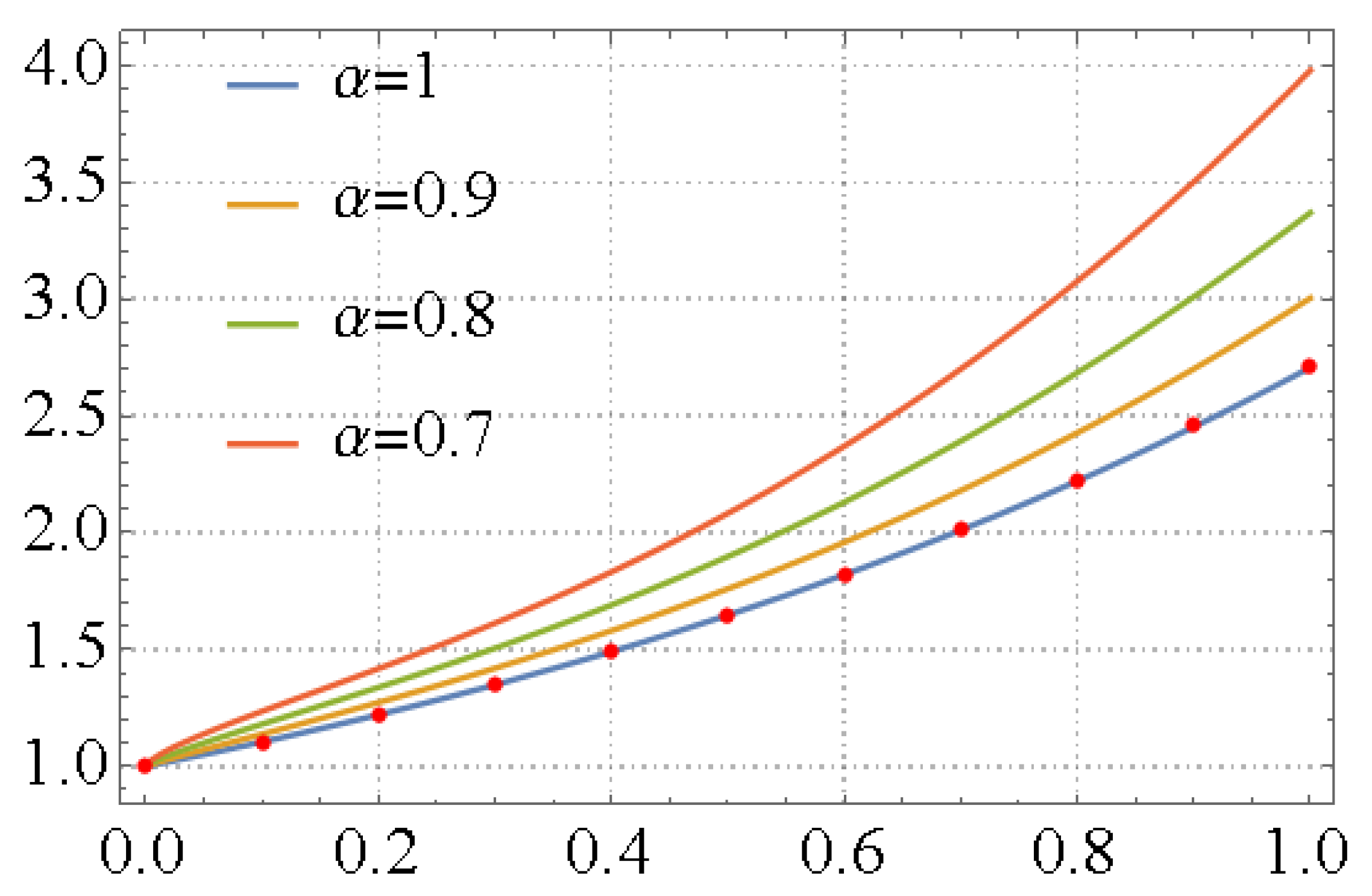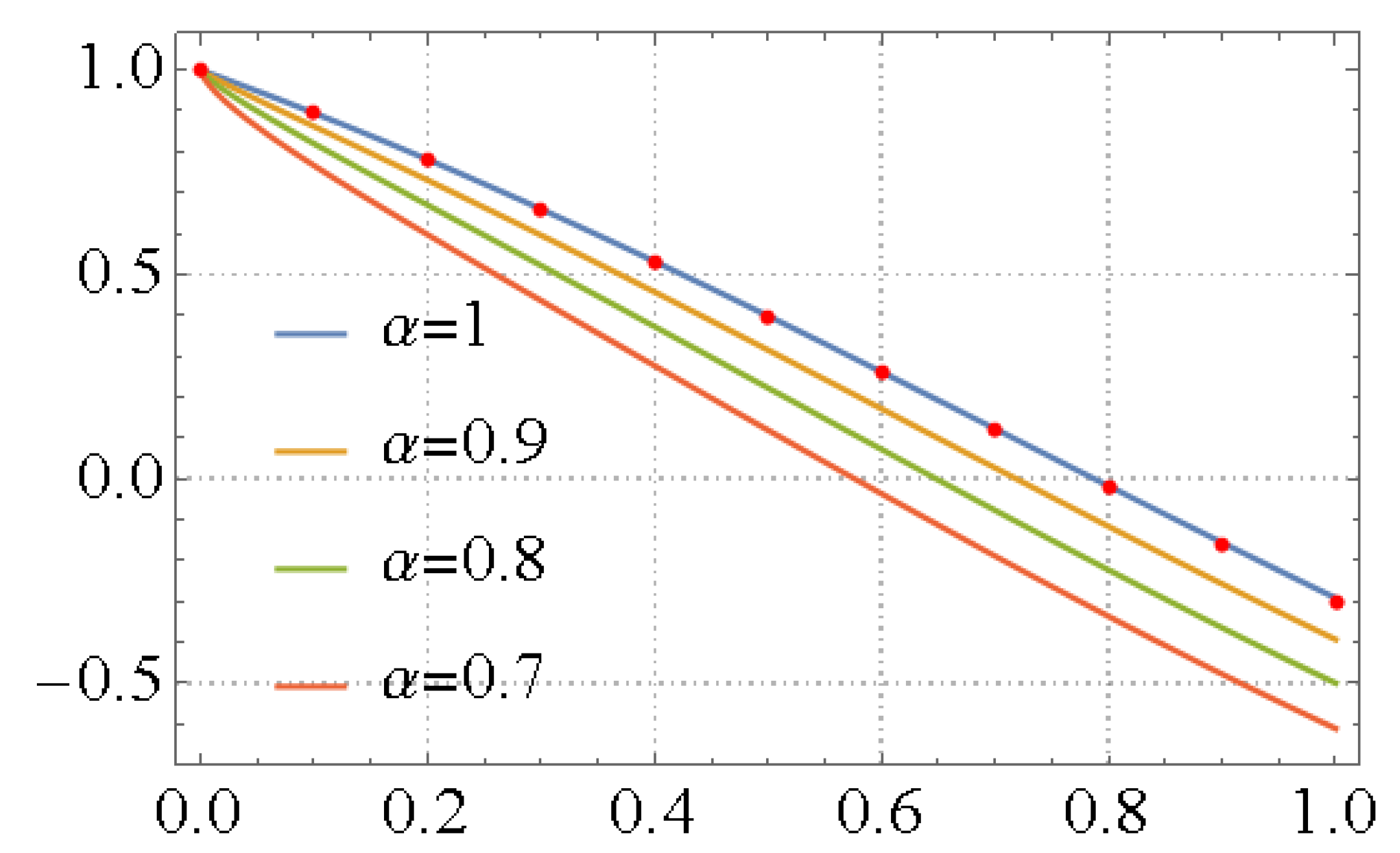Extended Laplace Power Series Method for Solving Nonlinear Caputo Fractional Volterra Integro-Differential Equations
Abstract
1. Introduction
2. Preliminaries and Basic Concepts
- i.
- .
- ii.
- iii.
- .
- iv.
3. Principle of the LFPS Algorithm
4. Illustrated Examples
- If is odd, then
- If is even, then
- The nonlinear term
5. Conclusions
Author Contributions
Funding
Data Availability Statement
Conflicts of Interest
References
- Loverro, A. Fractional Calculus: History, Definitions and Applications for the Engineer; Rapport Technique; University of Notre Dame, Department of Aerospace and Mechanical Engineering: Notre Dame, IN, USA, 2004. [Google Scholar]
- Mainardi, F. Fractional Calculus and Waves in Linear Viscoelasticity: An Introduction to Mathematical Models; World Scientific: Singapore, 2022. [Google Scholar]
- Yang, X.J. General Fractional Derivatives: Theory, Methods and Applications; CRC Press: Boca Raton, FL, USA, 2019. [Google Scholar]
- Kilbas, A.A.; Srivastava, H.M.; Trujillo, J.J. Theory and Applications of Fractional Differential Equations; Elsevier: Amsterdam, The Netherlands, 2006; p. 204. [Google Scholar]
- Inc, M.; Yusuf, A.; Aliyu, A.I.; Baleanu, D. Soliton solutions and stability analysis for some conformable nonlinear partial differential equations in mathematical physics. Opt. Quantum Electron. 2018, 50, 190. [Google Scholar] [CrossRef]
- Akdemir, A.O.; Dutta, H.; Atangana, A. Fractional Order Analysis: Theory, Methods and Applications; John Wiley & Sons: Hoboken, NJ, USA, 2020. [Google Scholar]
- Bagley, R.L.; Torvik, P.J. Fractional calculus in the transient analysis of viscoelastically damped structures. AIAA J. 1985, 23, 918–925. [Google Scholar] [CrossRef]
- Al-Smadi, M.; Djeddi, N.; Momani, S.; Al-Omari, S.; Araci, S. An attractive numerical algorithm for solving nonlinear Caputo–Fabrizio fractional Abel differential equation in a Hilbert space. Adv. Differ. Equ. 2021, 2021, 271. [Google Scholar] [CrossRef]
- Ragb, O.; Wazwaz, A.M.; Mohamed, M.; Matbuly, M.S.; Salah, M. Fractional differential quadrature techniques for fractional order Cauchy reaction-diffusion equations. Math. Methods Appl. Sci. 2023, 46, 10216–10233. [Google Scholar] [CrossRef]
- Hashim, I.; Sharadga, M.; Syam, M.I.; Al-Refai, M. A Reliable Approach for Solving Delay Fractional Differential Equations. Fractal Fract. 2022, 6, 124. [Google Scholar] [CrossRef]
- Povstenko, Y. Linear Fractional Diffusion-Wave Equation for Scientists and Engineers; Birkhäuser: New York, NY, USA, 2015. [Google Scholar]
- Syam, M.; Al-Refai, M. First order delay equations Implicit hybrid method. Alex. Eng. J. 2020, 59, 2677–2681. [Google Scholar] [CrossRef]
- Lopes, A.M.; Machado, J.A.T.; Pinto, C.M.A.; Galhano, A.M.S.F. Fractional dynamics and MDS visualization of earthquake phenomena. Comput. Math. Appl. 2013, 66, 647–658. [Google Scholar] [CrossRef]
- Hengamian Asl, E.; Saberi-Nadjafi, J.; Gachpazan, M. Numerical Solution of Fractional-Order Population Growth Model Using Fractional-Order Muntz–Legender Collocation Method and Pade–Approximations. Jordan J. Math. Stat. 2022, 15, 157–175. [Google Scholar]
- Hartley, T.T.; Lorenzo, C.F.; Killory Qammer, H. Chaos in a fractional order Chua’s system. IEEE Trans. Circuits Syst. I Fundam. Theory Appl. 1995, 42, 485–490. [Google Scholar] [CrossRef]
- Oldham, K.B. The reformulation of an infinite sum via semiintegration. SIAM J. Math. Anal. 1983, 14, 974–981. [Google Scholar] [CrossRef]
- Povstenko, Y.Z. Thermoelasticity that uses fractional heat conduction equation. J. Math. Sci. 2009, 162, 296–305. [Google Scholar] [CrossRef]
- Baskin, E.; Iomin, A. Electro-chemical manifestation of nanoplasmonics in fractal media. Cent. Eur. J. Phys. 2013, 11, 676–684. [Google Scholar] [CrossRef]
- Bapna, I.B.; Mathur, N. Application of fractional calculus in statistics. Int. J. Contemp. Math. Sci. 2012, 7, 849–856. [Google Scholar]
- Goncalves, E.; Zeidan, D. Numerical simulation of unsteady cavitation in liquid hydrogen flows. J. Eng. Syst. Model. Simul. 2017, 9, 41–51. [Google Scholar] [CrossRef]
- Kulish, V.V.; Lage, J.L. Application of fractional calculus to fluid mechanics. J. Fluids Eng. 2002, 124, 803–806. [Google Scholar] [CrossRef]
- Derdar, N. Nonlinear Implicit Caputo-Hadamard Fractional Differential Equation with Fractional Boundary Conditions. Jordan J. Math. Stat. JJMS 2022, 15, 999–1014. [Google Scholar]
- Bendouma, B. Monotone Iterative Technique for a Coupled System of Nonlinear Conformable Fractional Dynamic Equations on Time Scales. Jordan J. Math. Stat. JJMS 2023, 16, 41–55. [Google Scholar]
- Al-Smadi, M.; Al-Omari, S.; Karaca, Y.; Momani, S. Effective Analytical Computational Technique for Conformable Time-Fractional Nonlinear Gardner Equation and Cahn-Hilliard Equations of Fourth and Sixth Order Emerging in Dispersive Media. J. Funct. Spaces 2022, 2022, 4422186. [Google Scholar] [CrossRef]
- Alaroud, M.; Alomari, A.-K.; Tahat, N.; Al-Omari, S.; Ishak, A. A Novel Solution Approach for Time-Fractional Hyperbolic Telegraph Differential Equation with Caputo Time Differentiation. Mathematics 2023, 11, 2181. [Google Scholar] [CrossRef]
- Alaroud, M.; Al-Smadi, M.; Rozita Ahmad, R.; Salma Din, U.K. An Analytical Numerical Method for Solving Fuzzy Fractional Volterra Integro-Differential Equations. Symmetry 2019, 11, 205. [Google Scholar] [CrossRef]
- Ma, C. A Novel Computational Technique for Impulsive Fractional Differential Equations. Symmetry 2019, 11, 216. [Google Scholar] [CrossRef]
- Mahmood, S.; Shah, R.; Khan, H.; Arif, M. Laplace Adomian Decomposition Method for Multi Dimensional Time Fractional Model of Navier-Stokes Equation. Symmetry 2019, 11, 149. [Google Scholar] [CrossRef]
- Youbi, F.; Momani, S.; Hasan, S.; Al-Smadi, M. Effective numerical technique for nonlinear Caputo-Fabrizio systems of fractional Volterra integro-differential equations in Hilbert space. Alex. Eng. J. 2022, 61, 1778–1786. [Google Scholar] [CrossRef]
- Zedan, H.A.; Alaidarous, E. Haar wavelet method for the system of integral equations. Abstr. Appl. Anal. 2014, 2014, 418909. [Google Scholar] [CrossRef]
- Biazar, J. Solution of systems of integral-differential equations by Adomian decomposition method. Appl. Math. Comput. 2005, 168, 1232–1238. [Google Scholar] [CrossRef]
- Abbasbandy, S.; Hashemi, M.S.; Hashim, I. On convergence of homotopy analysis method and its application to fractional integro-differential equations. Quaest. Math. 2013, 36, 93–105. [Google Scholar] [CrossRef]
- Baleanu, D.; Zibaei, S.; Namjoo, M.; Jajarmi, A. A nonstandard finite difference scheme for the modeling and non-identical synchronization of a novel fractional chaotic system. Adv. Differ. Equ. 2021, 2021, 308. [Google Scholar] [CrossRef]
- Maleknejad, K.; Aghazadeh, N.; Rabbani, M. Numerical solution of second kind Fredholm integral equations system by using a Taylor-series expansion method. Appl. Math. Comput. 2006, 175, 1229–1234. [Google Scholar] [CrossRef]
- Sahin, N.; Yuzbasi, S.; Gulsu, M. A collocation approach for solving systems of linear Volterra integral equations with variable coefficients. Comput. Math. Appl. 2011, 62, 755–769. [Google Scholar] [CrossRef]
- Liaqat, M.I.; Khan, A.; Alam, M.; Pandit, M.K. A highly accurate technique to obtain exact solutions to time-fractional quantum mechanics problems with zero and nonzero trapping potential. J. Math. 2022, 2022, 9999070. [Google Scholar] [CrossRef]
- Alshammari, M.; Al-Smadi, M.; Arqub, O.A.; Hashim, I.; Alias, M.A. Residual Series Representation Algorithm for Solving Fuzzy Duffing Oscillator Equations. Symmetry 2020, 12, 572. [Google Scholar] [CrossRef]
- Aljarrah, H.; Alaroud, M.; Ishak, A.; Darus, M. Adaptation of Residual-Error Series Algorithm to Handle Fractional System of Partial Differential Equations. Mathematics 2021, 9, 2868. [Google Scholar] [CrossRef]
- Zhang, Y.; Kumar, A.; Kumar, S.; Baleanu, D.; Yang, X. Residual power series method for time-fractional Schrödinger equations. J. Nonlinear Sci. Appl. 2016, 9, 5821–5829. [Google Scholar] [CrossRef]
- Tariq, H.; Akram, G. Residual power series method for solving time-space-fractional Benney–Lin equation arising in falling film problems. J. Appl. Math. Comput. 2017, 55, 683–708. [Google Scholar] [CrossRef]
- Kumar, A.; Kumar, S.; Singh, M. Residual power series method for fractional Sharma-Tasso-Olever equation. Commun. Numer. Anal. 2016, 1, 1–10. [Google Scholar] [CrossRef]
- El-Ajou, A. Adapting the Laplace transform to create solitary solutions for the nonlinear time-fractional dispersive PDEs via a new approach. Eur. Phys. J. Plus 2021, 136, 229. [Google Scholar] [CrossRef]
- Alaroud, M.; Tahat, N.; Al-Omari, S.; Suthar, D.L.; Gulyaz-Ozyurt, S. An Attractive Approach Associated with Transform Functions for Solving Certain Fractional Swift-Hohenberg Equation. J. Funct. Spaces 2021, 2021, 3230272. [Google Scholar] [CrossRef]
- Liaqat, M.I.; Okyere, E. Comparative Analysis of the Time-Fractional Black–Scholes Option Pricing Equations (BSOPE) by the Laplace Residual Power Series Method (LRPSM). J. Math. 2023, 2023, 6092283. [Google Scholar] [CrossRef]
- Aljarrah, H.; Alaroud, M.; Ishak, A.; Darus, M. Approximate Solution of Nonlinear Time-Fractional PDEs by Laplace Residual Power Series Method. Mathematics 2022, 10, 1980. [Google Scholar] [CrossRef]
- Alaroud, M.; Ababneh, O.; Tahat, N.; Al-Omari, S. Analytic technique for solving temporal time-fractional gas dynamics equations with Caputo fractional derivative. AIMS Math. 2022, 7, 17647–17669. [Google Scholar] [CrossRef]
- Alaroud, M.; Alomari, A.-K.; Tahat, N.; Ishak, A. Analytical Computational Scheme for Multivariate Nonlinear Time-Fractional Generalized Biological Population Model. Fractal Fract. 2023, 7, 176. [Google Scholar] [CrossRef]
- Oqielat, M.A.N.; Eriqat, T.; Al-Zhour, Z.; Ogilat, O.; El-Ajou, A.; Hashim, I. Construction of fractional series solutions to nonlinear fractional reaction–diffusion for bacteria growth model via Laplace residual power series method. Int. J. Dyn. Control 2023, 11, 520–527. [Google Scholar] [CrossRef]
- Moa’ath, N.O.; El-Ajou, A.; Al-Zhour, Z.; Eriqat, T.; Al-Smadi, M. A new approach to solving fuzzy quadratic Riccati differential equations. Int. J. Fuzzy Log. Intell. Syst. 2022, 22, 23–47. [Google Scholar]
- Wazwaz, A.M. The combined Laplace transform—Adomian decomposition method for handling nonlinear Volterra integro–differential equations. Appl. Math. Comput. 2010, 216, 1304–1309. [Google Scholar] [CrossRef]
 .
.
 .
.
 .
.
 .
.
| ti | α = 0.9 | α = 0.8 | α = 0.7 | α = 0.6 |
|---|---|---|---|---|
| 0.1 | ||||
| 0.2 | ||||
| 0.3 | ||||
| 0.4 |
| J | 20 | 40 | 60 | 80 | |
|---|---|---|---|---|---|
| ti | |||||
| 0.1 | |||||
| 0.2 | |||||
| 0.3 | |||||
| 0.4 | |||||
| ti | α = 0.9 | α = 0.8 | α = 0.7 | α = 0.6 | α = 0.5 |
|---|---|---|---|---|---|
| 0.1 | |||||
| 0.2 | |||||
| 0.3 | |||||
| 0.4 | |||||
| 0.5 |
| J | 20 | 40 | 60 | 80 | |
|---|---|---|---|---|---|
| ti | |||||
| 0.1 | |||||
| 0.2 | |||||
| 0.3 | |||||
| 0.4 | |||||
Disclaimer/Publisher’s Note: The statements, opinions and data contained in all publications are solely those of the individual author(s) and contributor(s) and not of MDPI and/or the editor(s). MDPI and/or the editor(s) disclaim responsibility for any injury to people or property resulting from any ideas, methods, instructions or products referred to in the content. |
© 2023 by the authors. Licensee MDPI, Basel, Switzerland. This article is an open access article distributed under the terms and conditions of the Creative Commons Attribution (CC BY) license (https://creativecommons.org/licenses/by/4.0/).
Share and Cite
Alomari, A.-K.; Alaroud, M.; Tahat, N.; Almalki, A. Extended Laplace Power Series Method for Solving Nonlinear Caputo Fractional Volterra Integro-Differential Equations. Symmetry 2023, 15, 1296. https://doi.org/10.3390/sym15071296
Alomari A-K, Alaroud M, Tahat N, Almalki A. Extended Laplace Power Series Method for Solving Nonlinear Caputo Fractional Volterra Integro-Differential Equations. Symmetry. 2023; 15(7):1296. https://doi.org/10.3390/sym15071296
Chicago/Turabian StyleAlomari, Abedel-Karrem, Mohammad Alaroud, Nedal Tahat, and Adel Almalki. 2023. "Extended Laplace Power Series Method for Solving Nonlinear Caputo Fractional Volterra Integro-Differential Equations" Symmetry 15, no. 7: 1296. https://doi.org/10.3390/sym15071296
APA StyleAlomari, A.-K., Alaroud, M., Tahat, N., & Almalki, A. (2023). Extended Laplace Power Series Method for Solving Nonlinear Caputo Fractional Volterra Integro-Differential Equations. Symmetry, 15(7), 1296. https://doi.org/10.3390/sym15071296








